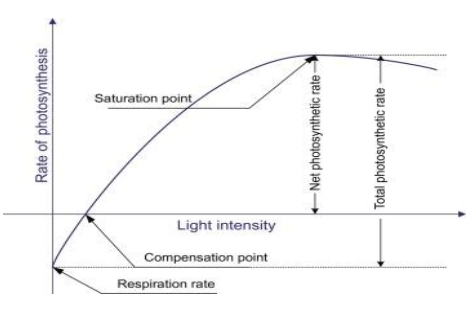
Compensation point is
A. Where there is neither photosynthesis or respiration
B. When rate of photosynthesis is equal to rate of respiration
C. When there is enough water just to meet the requirements of plant
D. When the entire food synthesized in photosynthesis remains unutilized
Answer
572.7k+ views
Hint: Compensation point is the point at which the photosynthesis and respiration are in balance. At the compensation point, the uptake of oxygen by respiration becomes equal to the photosynthetic release of oxygen.
Complete answer
The amount of oxygen produced by photosynthesis will be equal to the amount which is used by the respiration. The carbon dioxide assimilation is zero and at this point NO oxygen bubbles are present in the leaf disc. There is no bubble of carbon dioxide as it is more soluble in water.

The figure shows:
On the light curve, the compensation point is defined as a point where the rate of cellular respiration is equal to the rate of photosynthesis.
As the light intensity increases, the compensation point is reached. If it is reached beyond the compensation point, the rate of photosynthesis increases until the point of saturation is reached.
Photosynthesis depends on the intensity of sunlight whereas respiration is constant.
AT COMPENSATION POINT:
The plants neither consume nor build biomass because at this point the rate of photosynthesis is balanced to the rate of respiration.
This point occurs in early mornings and late evenings.
The net gaseous exchange is also zero
Photosynthesis depends on the intensity of sunlight whereas respiration is constant.
The correct answer is when the rate of photosynthesis is equal to the rate of respiration.
Note: At the compensation point, the net productivity is zero. No growth can occur at this point. It is a useful estimate of the lowest irradiance at which algae can maintain an autotrophic existence.
Complete answer
The amount of oxygen produced by photosynthesis will be equal to the amount which is used by the respiration. The carbon dioxide assimilation is zero and at this point NO oxygen bubbles are present in the leaf disc. There is no bubble of carbon dioxide as it is more soluble in water.

The figure shows:
On the light curve, the compensation point is defined as a point where the rate of cellular respiration is equal to the rate of photosynthesis.
As the light intensity increases, the compensation point is reached. If it is reached beyond the compensation point, the rate of photosynthesis increases until the point of saturation is reached.
Photosynthesis depends on the intensity of sunlight whereas respiration is constant.
AT COMPENSATION POINT:
The plants neither consume nor build biomass because at this point the rate of photosynthesis is balanced to the rate of respiration.
This point occurs in early mornings and late evenings.
The net gaseous exchange is also zero
Photosynthesis depends on the intensity of sunlight whereas respiration is constant.
The correct answer is when the rate of photosynthesis is equal to the rate of respiration.
Note: At the compensation point, the net productivity is zero. No growth can occur at this point. It is a useful estimate of the lowest irradiance at which algae can maintain an autotrophic existence.
Recently Updated Pages
Master Class 12 Business Studies: Engaging Questions & Answers for Success

Master Class 12 Economics: Engaging Questions & Answers for Success

Master Class 12 English: Engaging Questions & Answers for Success

Master Class 12 Maths: Engaging Questions & Answers for Success

Master Class 12 Social Science: Engaging Questions & Answers for Success

Master Class 12 Chemistry: Engaging Questions & Answers for Success

Trending doubts
What is meant by exothermic and endothermic reactions class 11 chemistry CBSE

Which animal has three hearts class 11 biology CBSE

10 examples of friction in our daily life

One Metric ton is equal to kg A 10000 B 1000 C 100 class 11 physics CBSE

1 Quintal is equal to a 110 kg b 10 kg c 100kg d 1000 class 11 physics CBSE

Difference Between Prokaryotic Cells and Eukaryotic Cells




